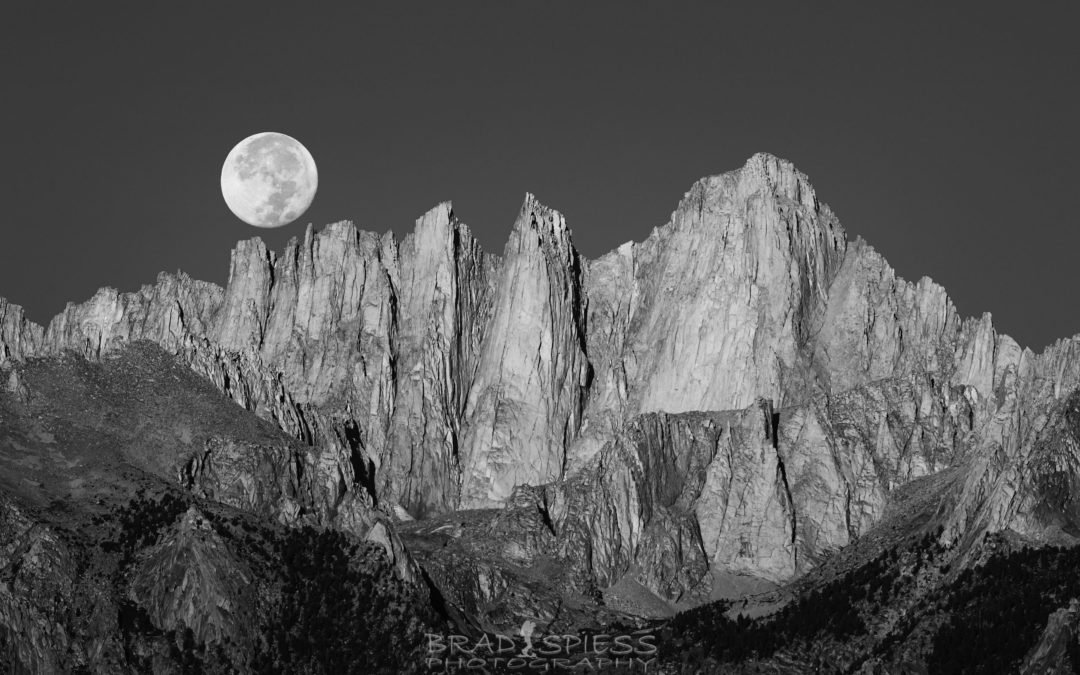Photographic Payoff
The Inspiration
Anyone who has been in photography for a while has an idea of a shot that just sticks in their head, maybe even several. A photographic idea that no matter whatever else you do just sits in the back of your mind and never leaves. You plan other shoots and get great results that you are pleased with, but you still have that nagging shot that you really want to capture. This is a good thing, like anything else in life, having a goal that push’s you out of your comfort zone and makes your stretch creatively will improve your skills in the long run. This is the story of one such shot for me, the shot of the full moon as it descends behind Mt Whitney, a mountain in the Eastern Sierra range that happens to be the tallest peak in the lower 48 states, standing at 14,505 feet high.
Mt Whitney has some personal connections for me. I’ve climbed it twice, and I pass by it every year as I travel up the eastern sierras to snowboard in Mammoth Mountain. I think that anyone who has climbed Mt Whitney can attest that once you have been up the mountain you can’t un see it. What I mean by that is that for years I drove past Mt Whitney without really giving it a 2nd thought. Once I climbed Mt Whitney or even thought about climbing it I was not able to pass by the mountain ( which you have to do if your driving up the Eastern Sierras) without looking up at the peak in awe. Maybe that is just me, but I find that to be the case for almost any mountain that I’ve hiked. Even local mountains that I may have hiked over a hundred times I can not pass by without at least glancing up. Mt Whitney was special though, and it had such a rugged appearance that makes it so photogenic. So eventually this mountain made it into my psyche and while looking at other photographers work of the area I came across photographs with the moon that I thought to be pretty cool, and like any photographer I don’t want a photograph that someone else took of that area I want one that I took.
Putting a Plan Together
Once I became interested in shooting the moon with Mt Whitney I started to do some research to find out what I needed to do in order to capture the shot. Somewhere along the way I came across the information that the moon typically only lines up with Mt Whitney about twice a year. I mainly use the app Planit Pro for planning out my lunar shots. I feel like it gives me more precise control in planning out my shots and with the Virtual Reality View Finder in the planning app I can play around with my camera set up spot until I get exactly the picture I am looking for so that I know where I will need to set up my camera. For this shot I had planned on using a spot about 16 miles away so that I could use my lens at 600 mm in order to get a larger version of the moon along side Mt Whitney, and as predicted the full moon would only line up about twice a year according to the app.
My First Attempt
My first attempt at taking the photo I was looking for came around March of 2019. The date also worked out perfectly with setting up a trip for two buddies and I to do some snowboarding up in Mammoth Mountain. As the time neared I keep checking weather reports to see if everything was going to line up, I was going up to go snowboarding as well and this was on the way so even if it did not workout it did not feel like a total loss. The weather called for a partly cloudy day the day off and the night we pulled into Lone Pine the clouds seemed to be breaking up and maybe promising. I grabbed a couple of shots that evening at sunset as we were grabbing dinner in town.
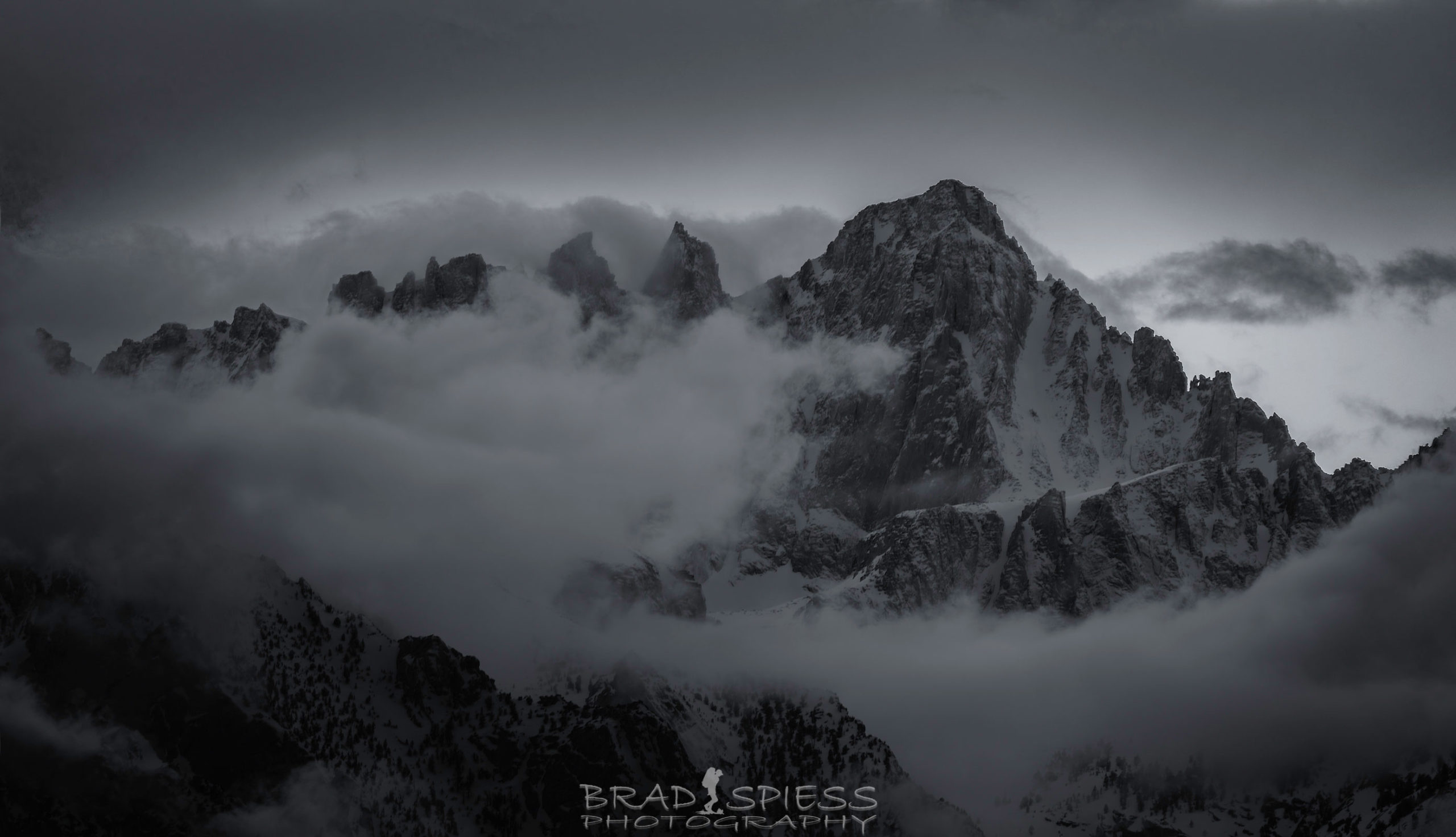
The clouds looked like they may break up for the next day as I took shots at sunset.
The next morning I woke up early in the morning and left my compatriots in the room as I headed out to my spot to grab the shot. The sky did not look promising but I took the chance and set up to get the shot. As the time drew closer though I knew the shot was not meant to be, I could not even see the moon through the clouds. So I decided to head on over to another spot I had been photographing the night before and try my luck with a sunrise shot, The Boot Arch. I got some interesting shots there but not what I was envisioning, the clouds were so thick very little light made it through.
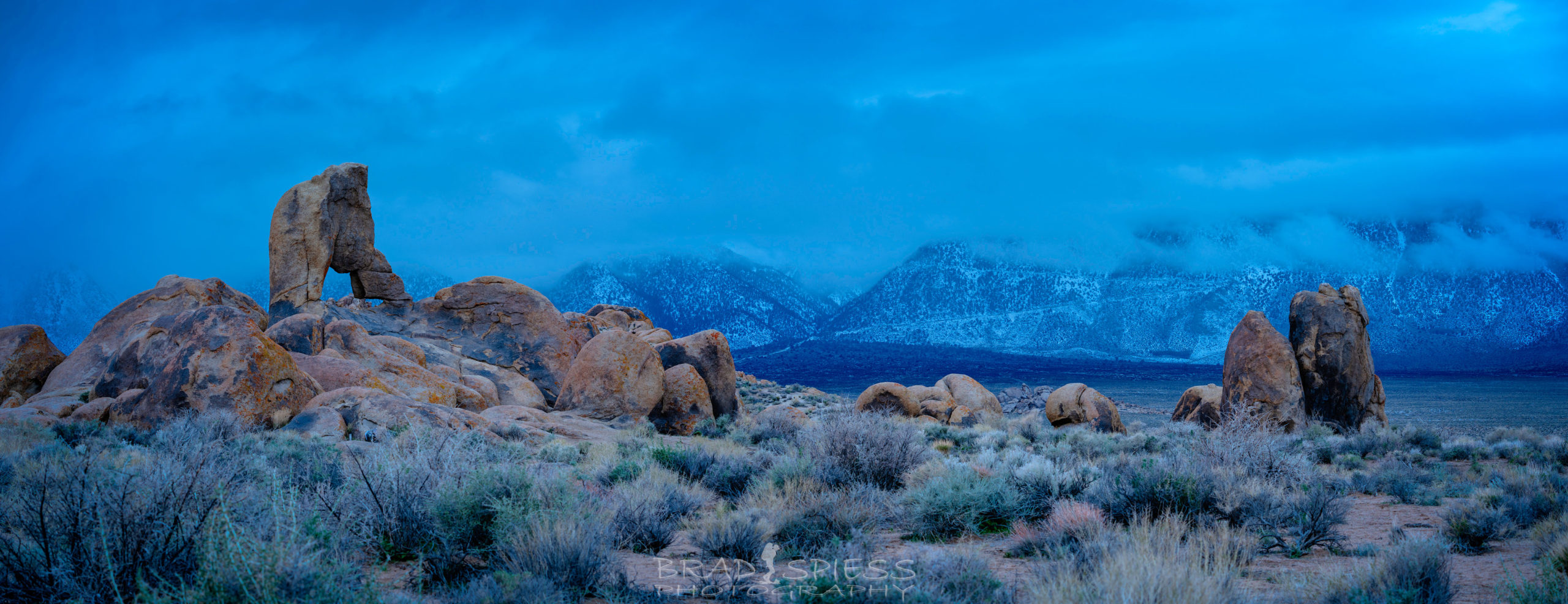
The clouds really blocked out the light during this sunrise at Boot Arch in the Eastern Sierras.
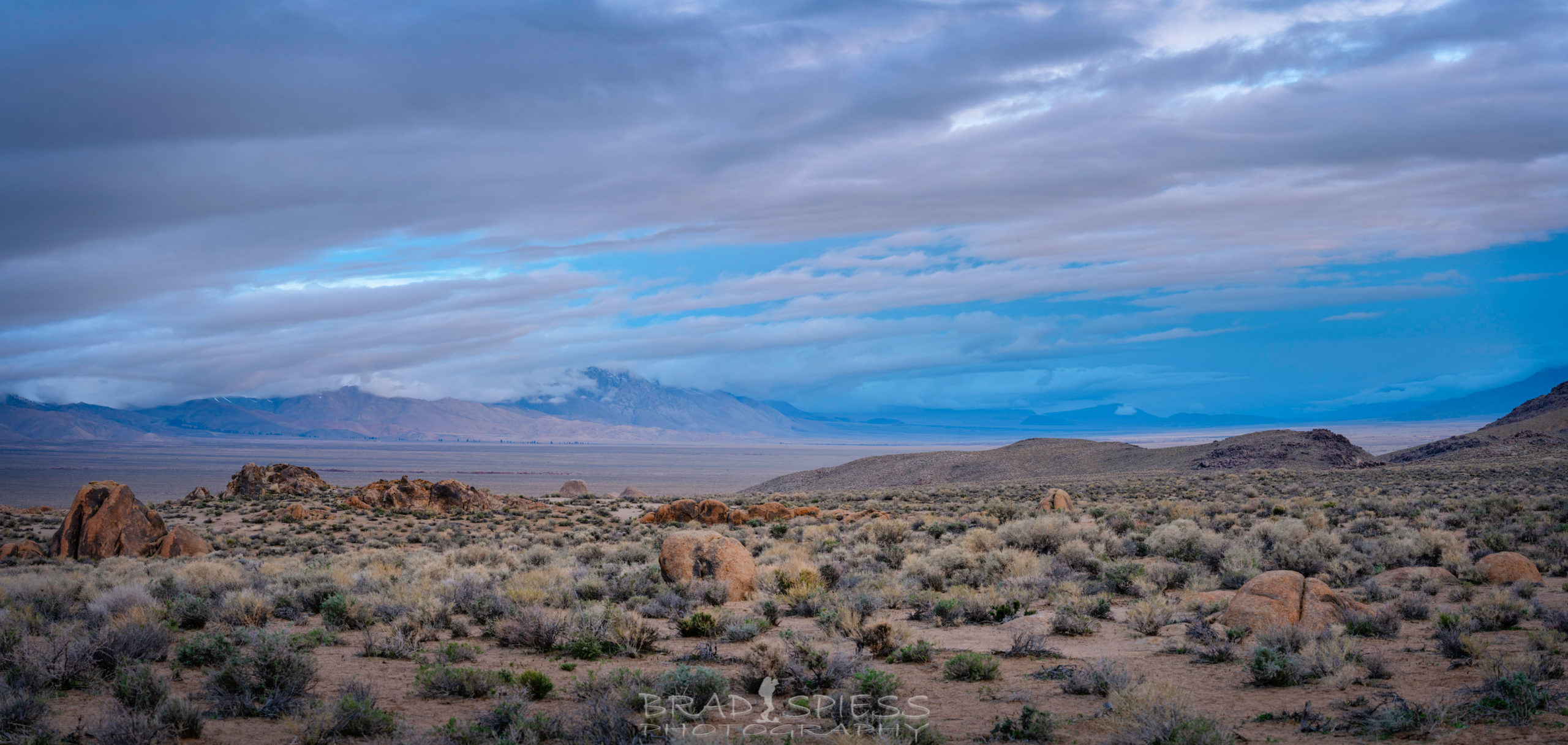
Looking north along the sierras as the morning sun try’s to add some color to the sky
My 2nd Attempt
One thing I love about using the app Planit Pro for planning out these shots is that I can keep using the same plan and just change the date and the app will show me when and where the moon will show up. Then I can play with my camera spot in the app until it lines up, so this is something I typically do when heading back to the same spot that I may have shot before while using the app to plan it out. Unfortunately the next time the moon lined up with Mt Whitney in 2019 did not work out for me, so I started to plan for the year 2020. It lined well with sunrise in April and I set my plan into motion for that time. Unfortunately fate had other plans and everything went into lockdown for Covid-19,…so that plan fell through. Well as the Covid-19 restrictions were loosened up, getting to shoot Mt Whitney started to look more promising for September 2020, so I started planning for that shot. Again I already have my previous plan so all I need to do to find where I need to place my camera is to change the date in the app and then play with the camera position until it lines up where I want it to. The spot I chose was not to far from my previous spot.

My plan showing my camera spot and the target at the top of Mt Whitney almost 16 miles away
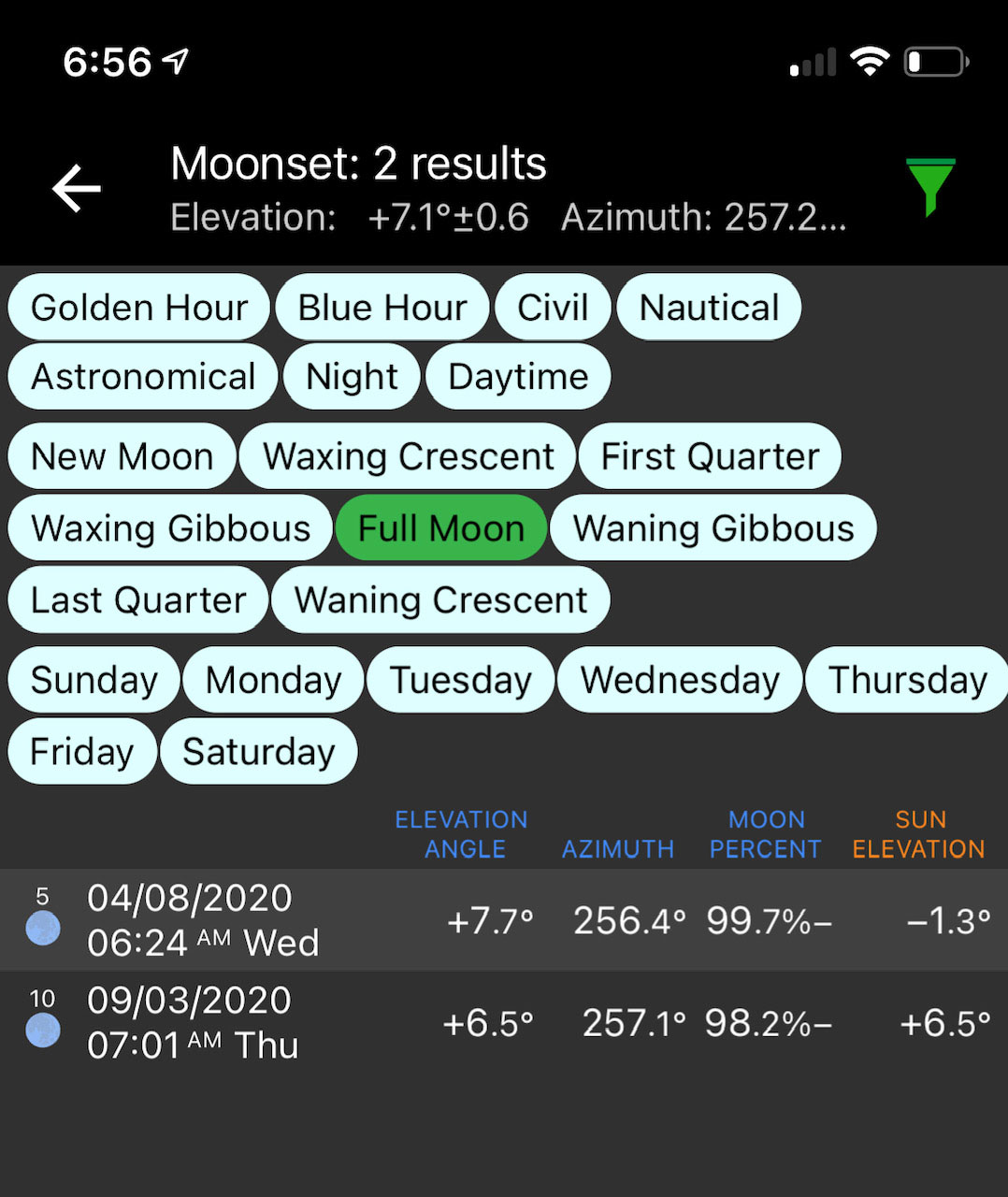
My plan showing two different dates for the year 2020 when a full moon would line up with Mt Whitney at sunrise.
As the time got closer I took 2 days off of work so that I could enjoy the experience. Mt Whitney is only 4-5 hours north from where I live in San Diego, so its close enough I can plan on getting there relatively easy but far enough away where I don’t want to just drive up there, shoot, and then come back. I had reserved a camping spot at Lone Pine Campgrounds, its a nice little campground situated right at the bottom of the hills next to Lone Pine Creek at 6000 feet, I had camped there before and really liked the area, I even got my favorite spot right next to the creek. As the time grew closer though I started to worry about the smoke from all the fires obscuring the view of Mt Whitney. In fact 2-3 days before I headed up to Lone Pine I was checking the Mt Whitney climbing forum Whitneyzone.com which has two web cams showing Mt Whitney and noticed that the mountain was completely obscured by smoke. While perusing the forum for more information I came across a link to a fire and smoke map that seemed to be updated hourly at fire.airnow.gov. This gave me something to check to see what was going on with the smoke apart from just the web cam and it seemed to show the situation was improving which made me more hopeful. While the situation was improving I started to think that I may not want to camp and breath in all that smoke so I was able to get a room in town which was nice because the day I arrived in Lone Pine it was around 100 degrees, it was nice to use the air conditioning in the room.
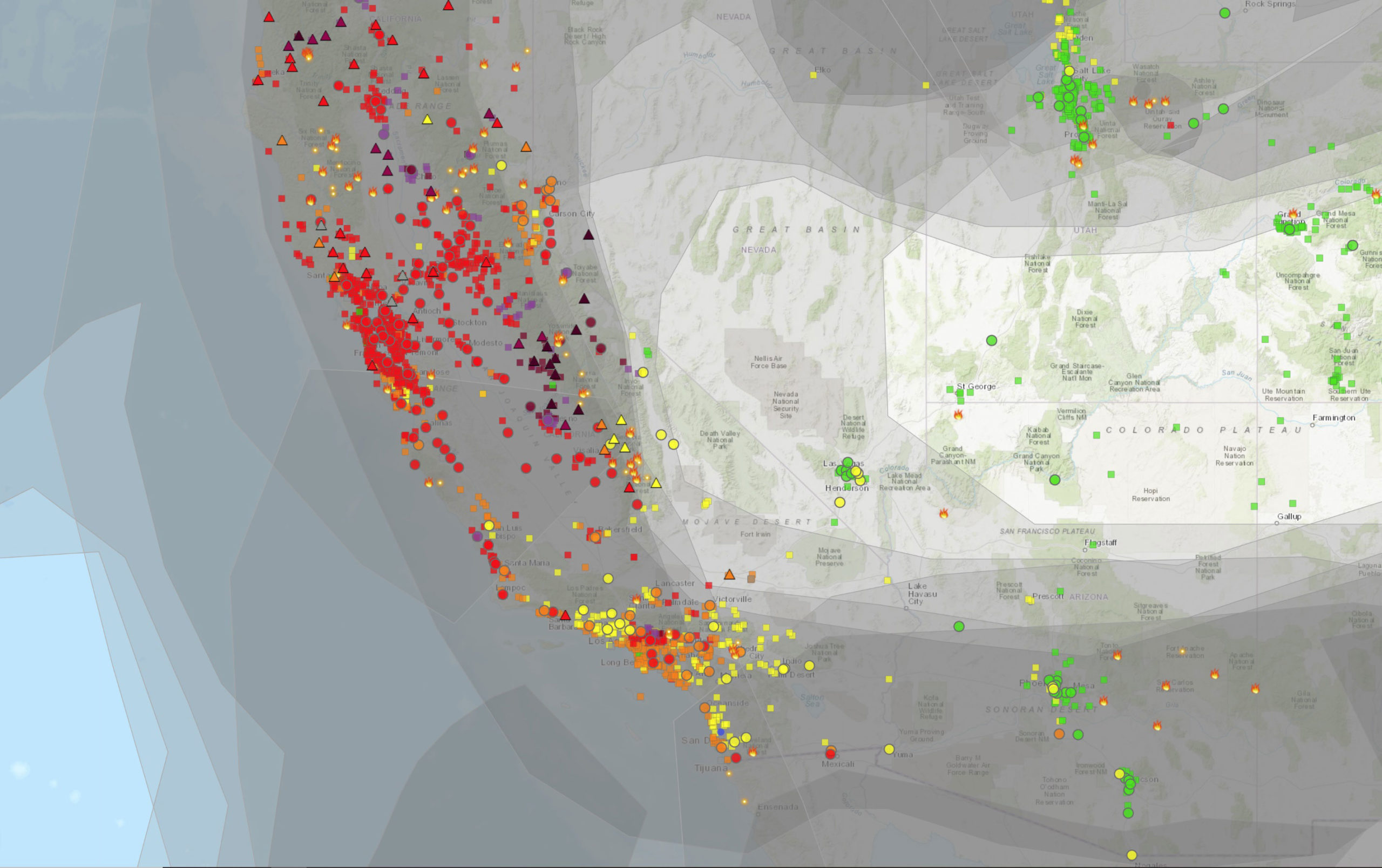
A smoke map of the area, this was taken two weeks later but I wanted to you to see how much detail it gave.
It makes sense not to have all your photographic hopes on one spot, so once I got settled into my room and had some lunch I headed out first to double check my spot and possibly look for other backup spots. If the sky was to hazy from the smoke then I could move up closer to the mountain and grab a shot of the moon a little earlier in its descent, this would give me the advantage of having the moon appear brighter and help cut through the haze, the disadvantage would be the moon would look smaller against the mountains. I spent a little time looking around and planning on my app and picked 3 spots. The original spot about 16 miles away that allowed me to shoot with my lens all the way at 600 mm, and two closer spots that allowed me to get the moon a little earlier but cut my focal distance to 300-400 mm.
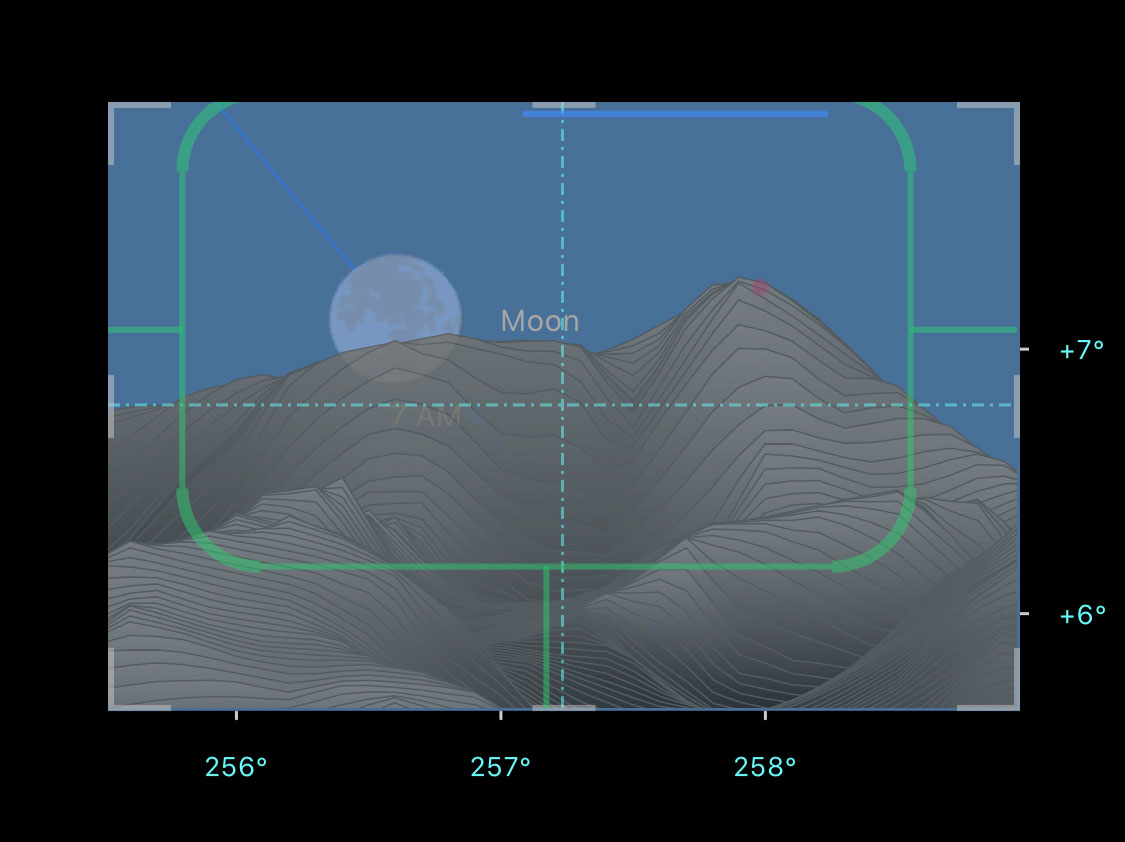
What my shot would look like at 600 mm from about 16 miles away on the Planit Pro App
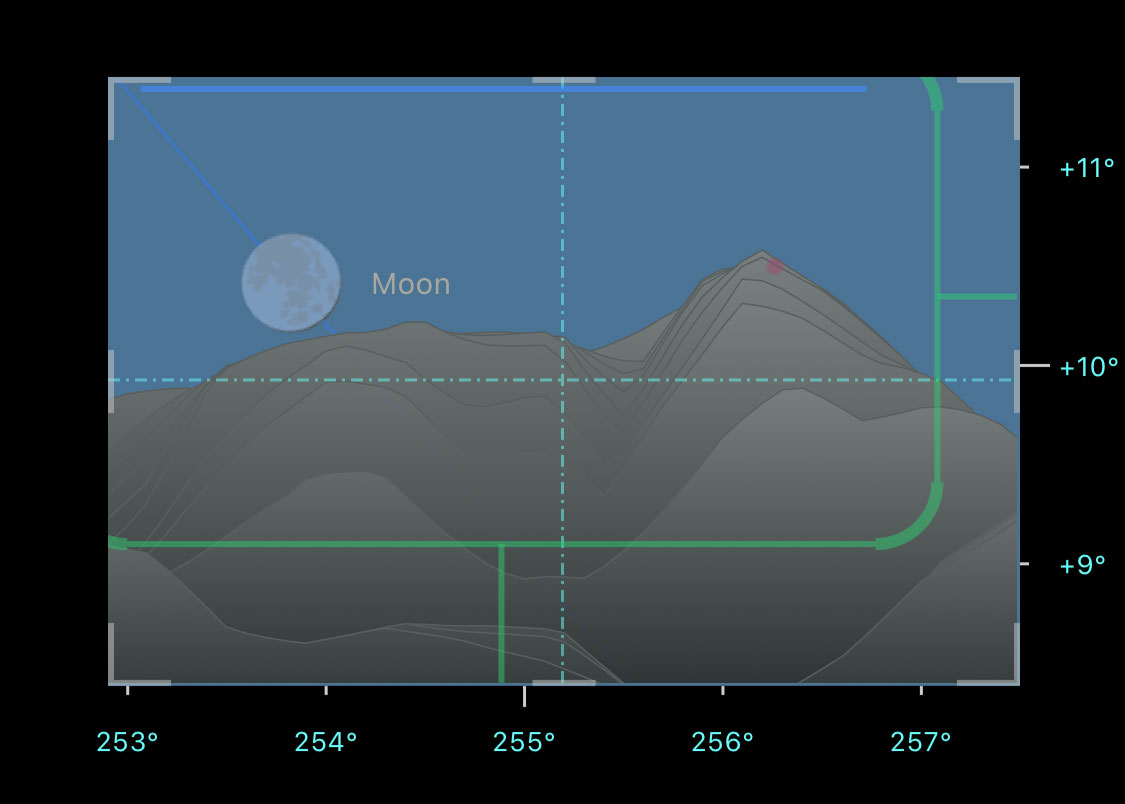
What my shot would look like at 400 mm from about 10 miles away with the Planit Pro App
Whenever I am traveling somewhere to photograph I like to explore the area around there for other potential photographic spots, so after picking my spots I decided to head up the Portal Road to Whitney Portal, where all the hikers take off for hiking to the top of Mt Whitney. I had read that there was a beautiful waterfall there and I don’t remember seeing it the previous two times I was up there but that was probably because I was super focused on the hiking aspect of Mt Whitney. I thought a nice shady spot on some creek might make a nice photo op and this seemed to fit the bill not to mention it was much cooler at the high altitude, going from 100 degrees down to 78 degrees at the portal which is around 8374 feet of elevation. If you take the portal road until it ends you will be in the Whitney Portal parking lot. Head as far back as you can and you can’t miss the sound of the waterfall, look up and you will see it starting far above you as it cascades down towards the parking lot. A little planning would have made this a much better photo, as I was checking out the spot I noticed the sun giving a nice sun flare just before it disappeared behind the mountains, unfortunately by the time I set up that opportunity had evaded me. This was a nice spot to play around with, there were several level spots at different points in the waterfall that you could use to shoot from, I decided to take the middle area and played around using a 6 stop ND filter on my 16-35 mm to help get some silky motion to the water. I would love to come back to this spot when there is some snow on the area and see what I can capture. After the light started to fade I reluctantly decided to leave the lower temperatures of Whitney Portal and descend back down into the Alabama Hills to try my luck with the Boot Arch.
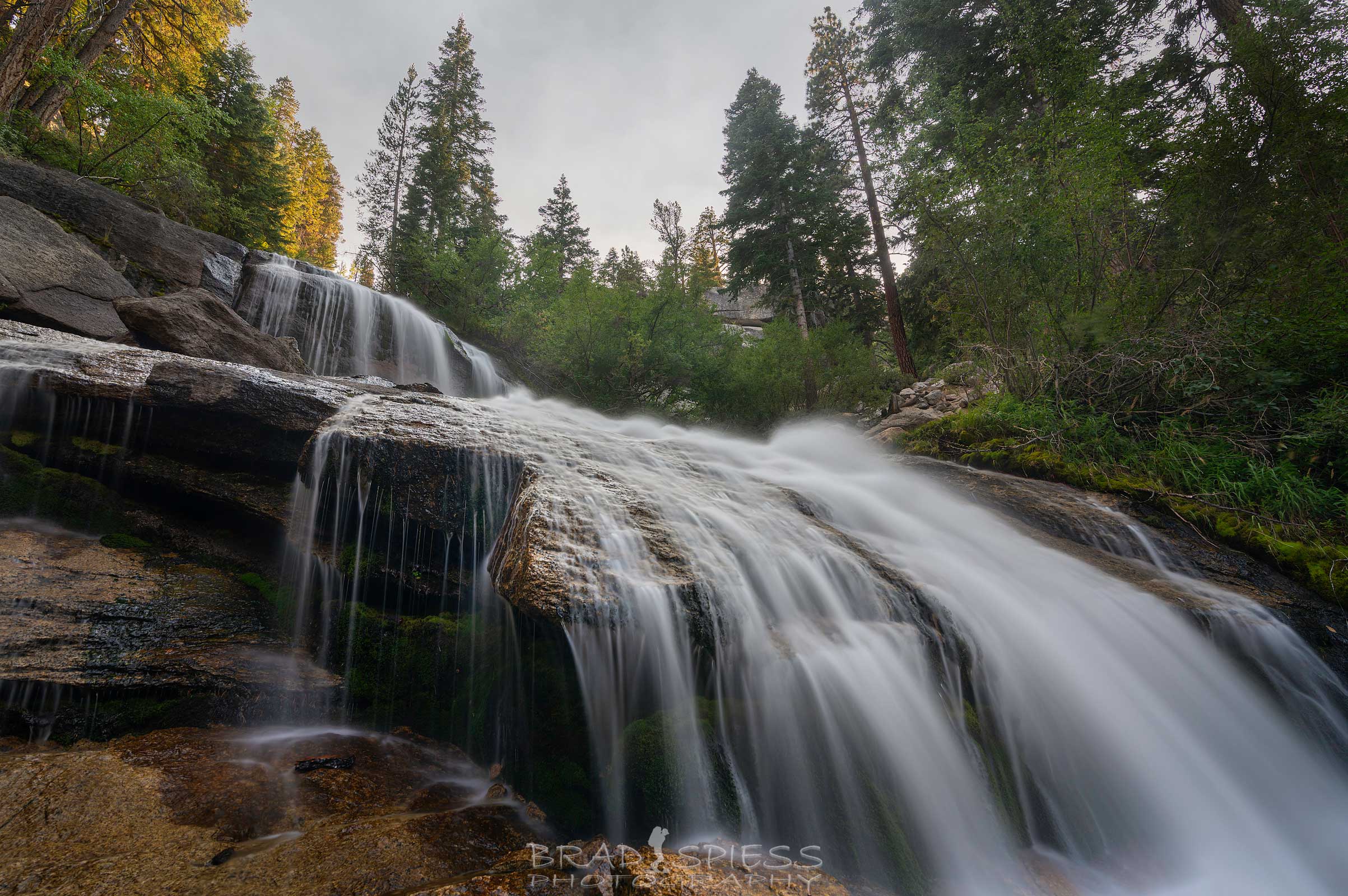
The Lone Pine Creek Waterfall at the back of Whitney Portal.
I have shot the Boot Arch before in Alabama Hills and no doubt you have seen many photos from your favorite photographers showing this arch in sunsets or with the Milky Way. The sky was remarkably clear so I just wanted to capture the arch with a starry night behind it. Lets just say the moon overpowered the stars. As the full moon rose in the east the surrounding rocks cast to many shadows that I did not like on the arch when shooting close up with my 14 mm. However I really liked what the moon light was doing for illuminating the Sierra mountains behind the arch and so I decided to make that part of the composition.
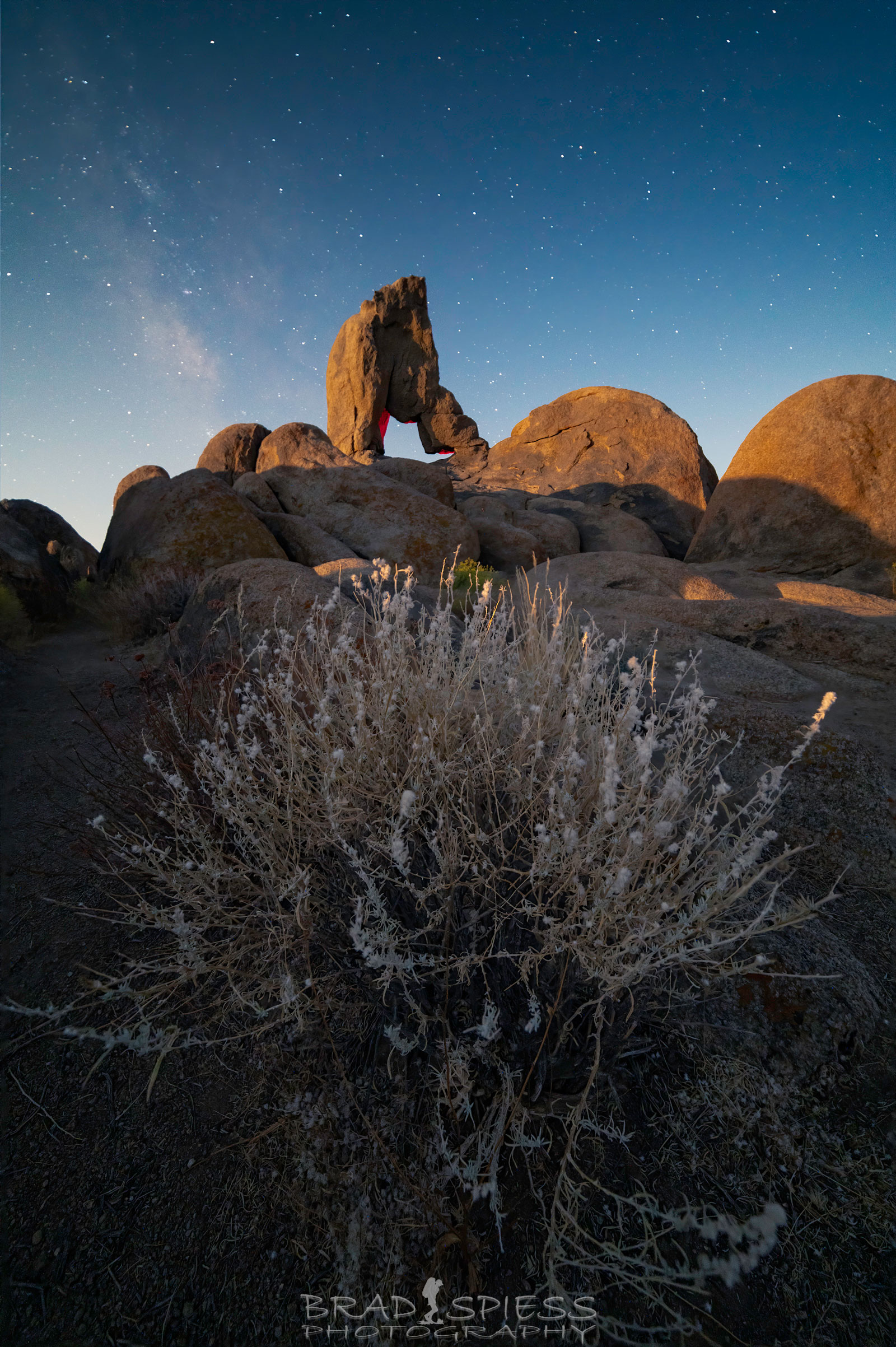
Focus stacked 3 images with 14 mm f/2.8 . The full moons light just over powers the scene.
I grabbed my 70-200 mm f/2.8 and decided to make a pano of the composition. I had done this previously and liked the results so I decided to give a try again. I wanted the Boot Arch in the foreground but I also wanted to mountains in the background to be pretty prominent so I backed up pretty far away from the Boot Arch and shot my pano at 104 mm. I decided to shot 2 panos, one to hightlight the foreground shot at ISO 3200, f/8,30 seconds and the 2nd at ISO 3200, f/2.8, and 4 seconds to highlight the night sky. I then blended to two in photoshop. I really like how the full moon illuminated the Sierra Mountains in the background.
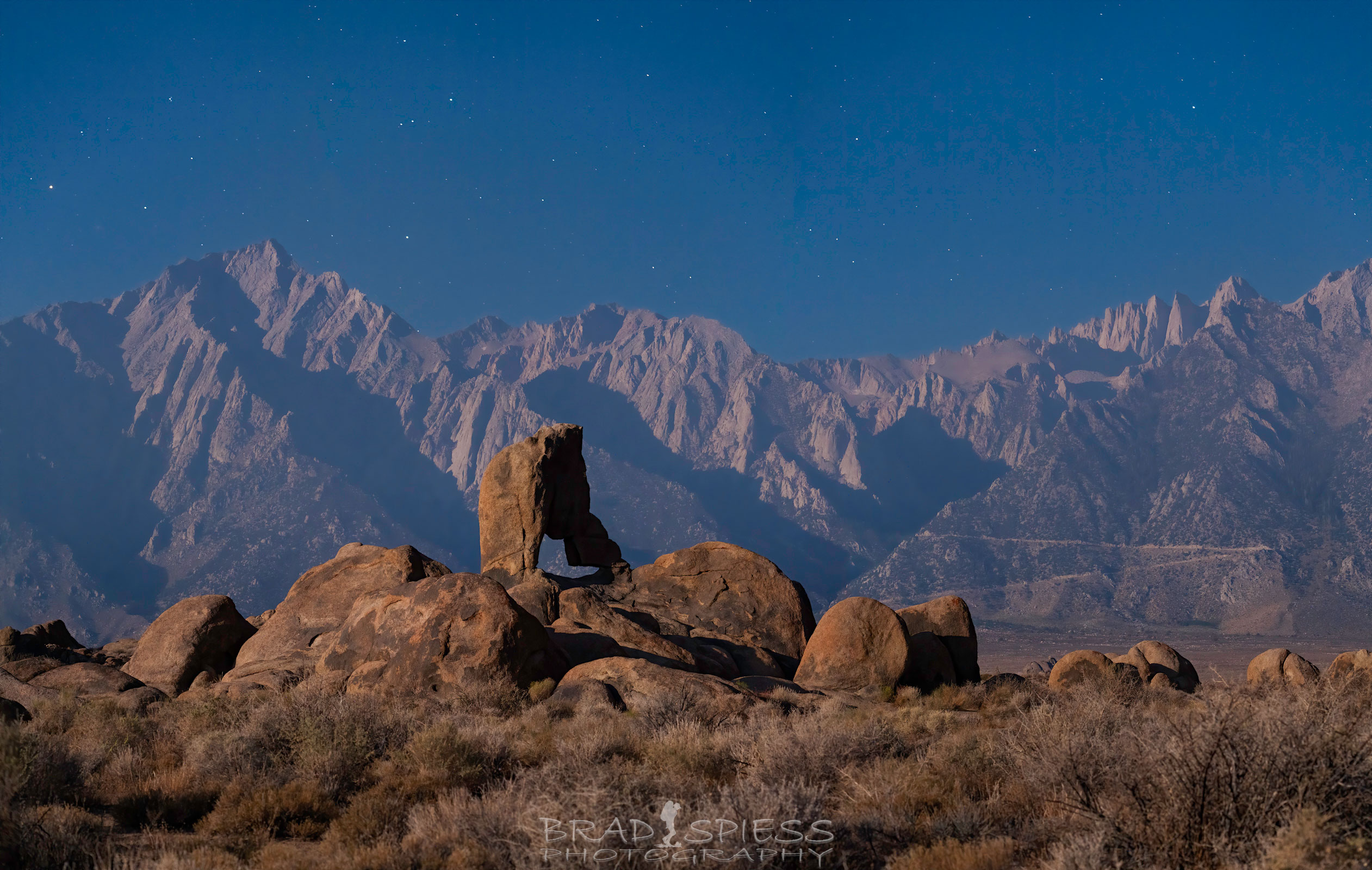
The full moon illuminating the Boot Arch in the foreground while also illuminating the Eastern Sierra range in the back ground.
After playing around with Boot Arch for a little bit I decided it was time to head back to my room so I could get some sleep and get up early in the morning. I probably got up to early, I got up at 5:30 am and swung by the local McDonalds to grab a breakfast sandwich and coffee, but they were still closed. I thought the mountain range looked a little hazy in the early morning so I decided to go for the closer option in hopes of getting a clearer image of the mountains and with the moon being slightly higher in the sky and brighter therefore cutting through any haze better, but I need not have worried because I could not have asked for better conditions. I drove out to a spot that I had scouted out on “Movie Road” in the Alabama Hills the day before. I was happy to find that I had the whole place to myself when I got there. I decided to set up two cameras, one for my 200-600 mm lens and the other for my 70-200 mm lens so that I could capture different scenes simultaneously. I really need to get myself a 2nd beefy tripod for just such occasions. My only wish would have been for the moon to have been in position slightly sooner when the mountains first started to get the “Alpine Glow” as the sun first starts to light up the mountain range.
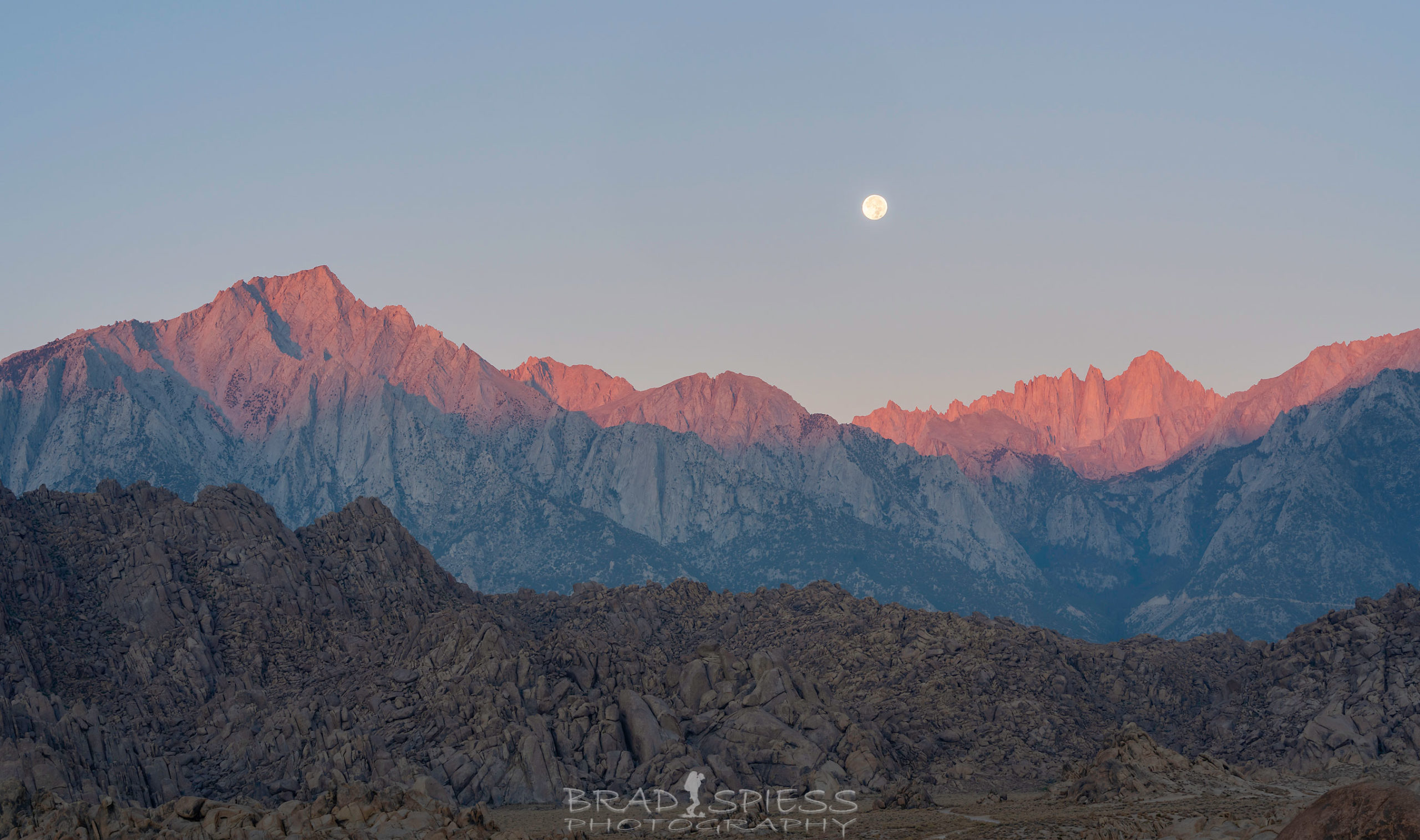
The Alpine Glow lighting up the Sierra Mountain Range as the full moon descends towards Mt Whitney.
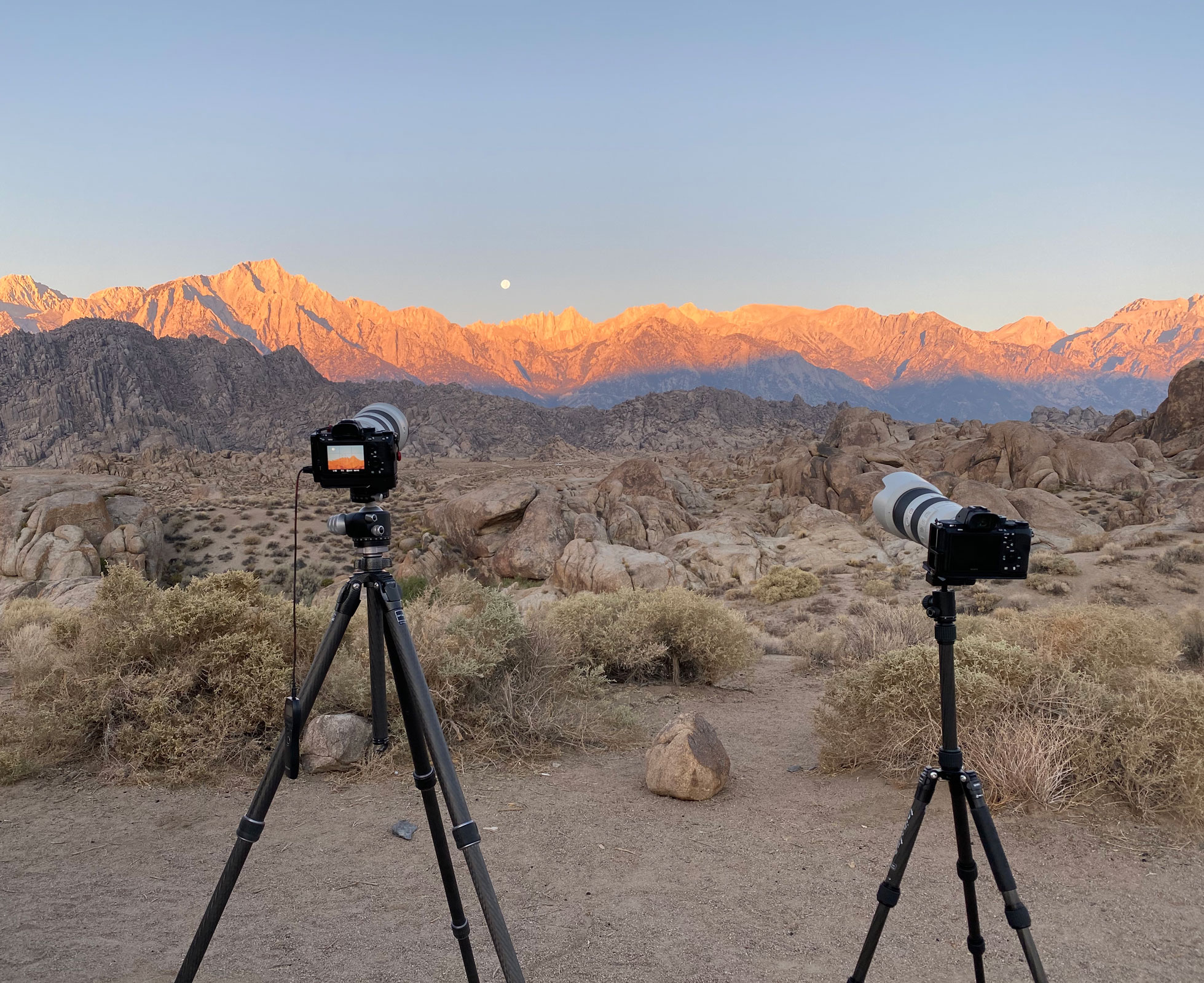
My two cameras set up for the shot, one with the 200-600 mm lens on the left side and the other with my 70-200 mm lens on the right side.
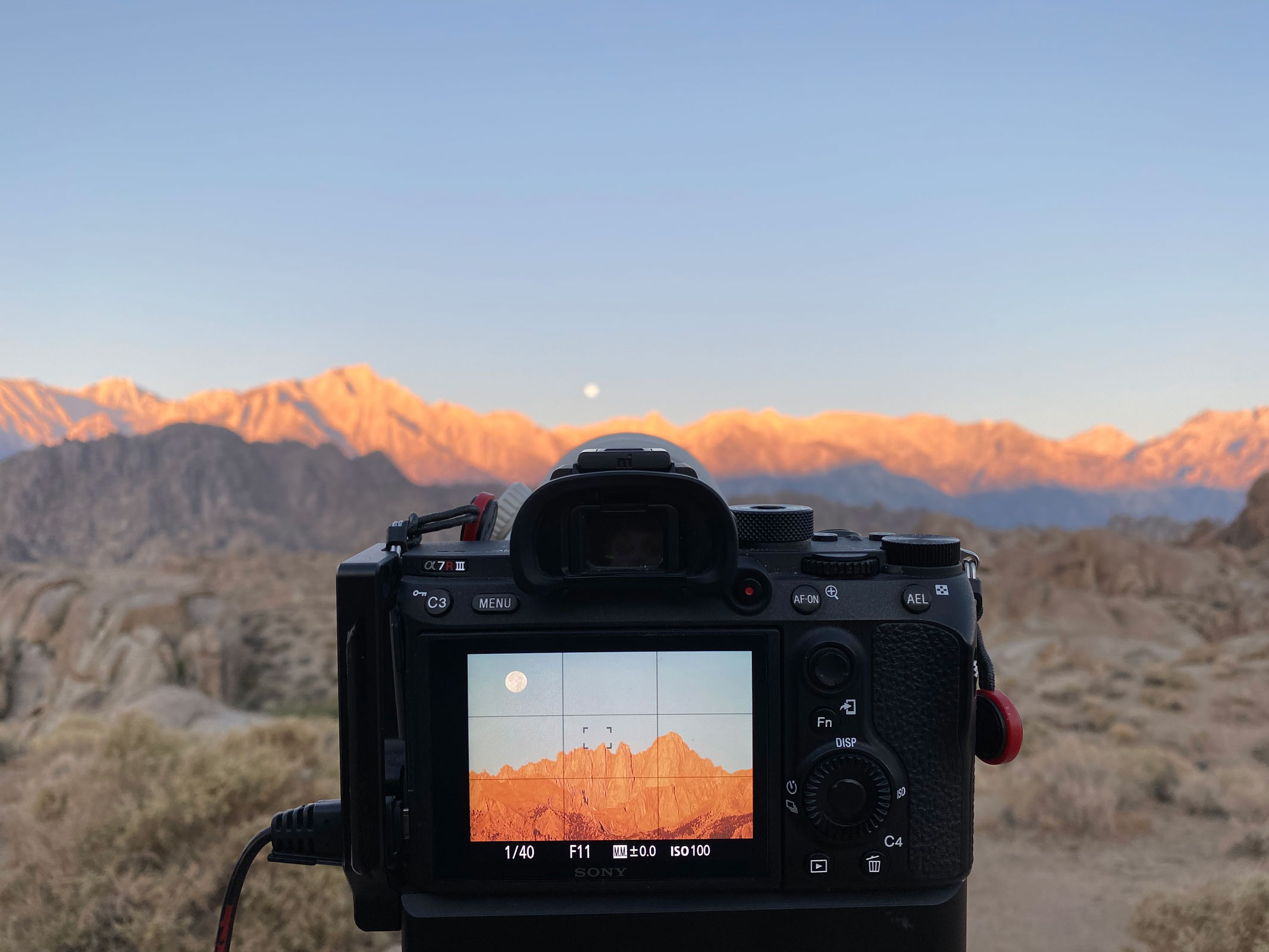
A look at the scene through the back of my camera
I went back and forth with both camera set ups but focused mainly on using the 70-200 mm lens until the moon got into the range I wanted to use with the 200-600 mm lens. I shot in landscape mode for most of it but I started to like the vertical composition with the 70-200 mm as the moon got closer to the mountain and you could see the layers of the landscape. Its funny how some things seem like such great ideas as you are working on them at the scene but no so much as you work on them with post processing. As much as I liked the layer effect, I should have waited a little longer and gotten the light as it started to lighten up the tops of the Alabama Hills and then blended the images, unfortunately I did not see the light on the hills until after I had packed up and was leaving.
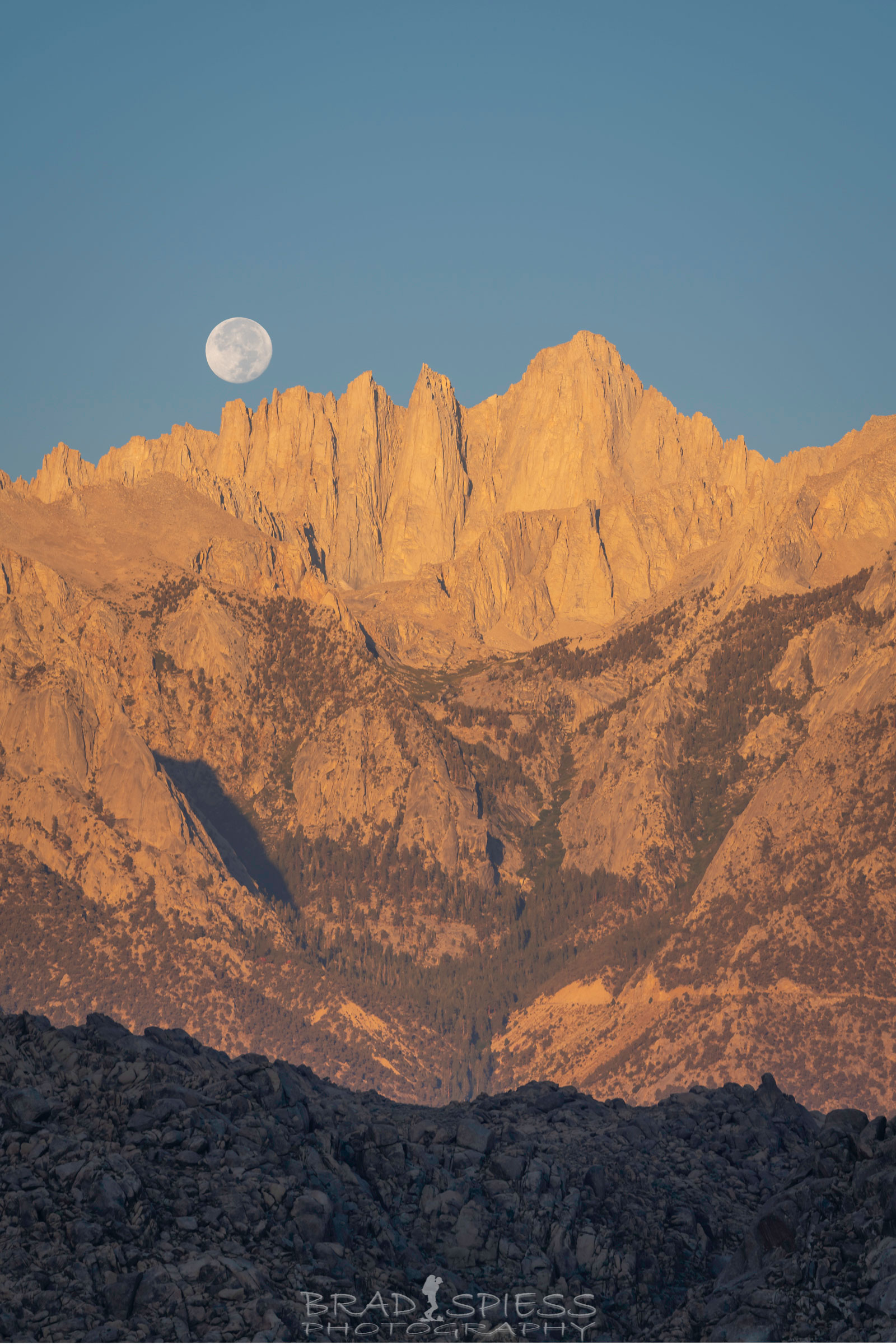
My vertical composition of the moon descending towards Mt Whitney at sunrise with the Alabama Hills in the foreground.
As the moon got closer to the mountain range I switched to mainly shooting with the 200-600 mm lens trying several focal lengths. I decided I liked the focal length at 335 mm instead of the 407 mm I shot because of the dark layer of trees at the bottom more apparent in the 335 mm shot that seemed to bring more focus back to the mountain. As I processed the images latter I was not happy with how the mountains lit up so well with the orange red of sunrise detracted away from the moon, I decided that with black and white the moon seemed to accent the mountains more then compete with them for your attention. See what you think. I’m pretty happy with the results, I think the only things I would like to change and try again would be to shot from further away so I can get the moon larger at 600 mm and to get the moon a little earlier as it descends when the morning light isn’t so powerful on the mountain range, I think it would look better with the softer start of the Alpine Glow illuminating the tops of the peaks. There is always next time.
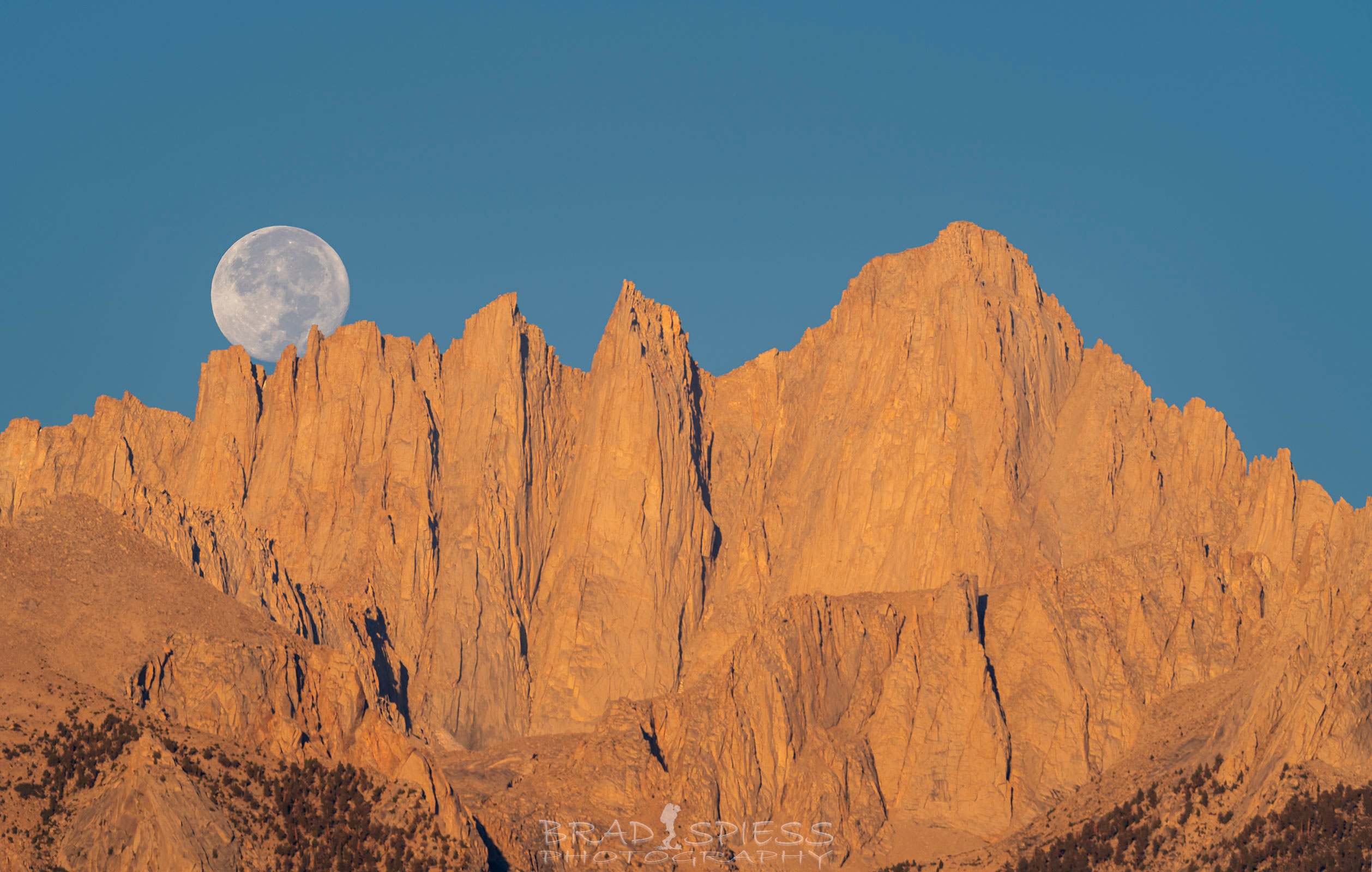
The Descending Moon shot at 407mm
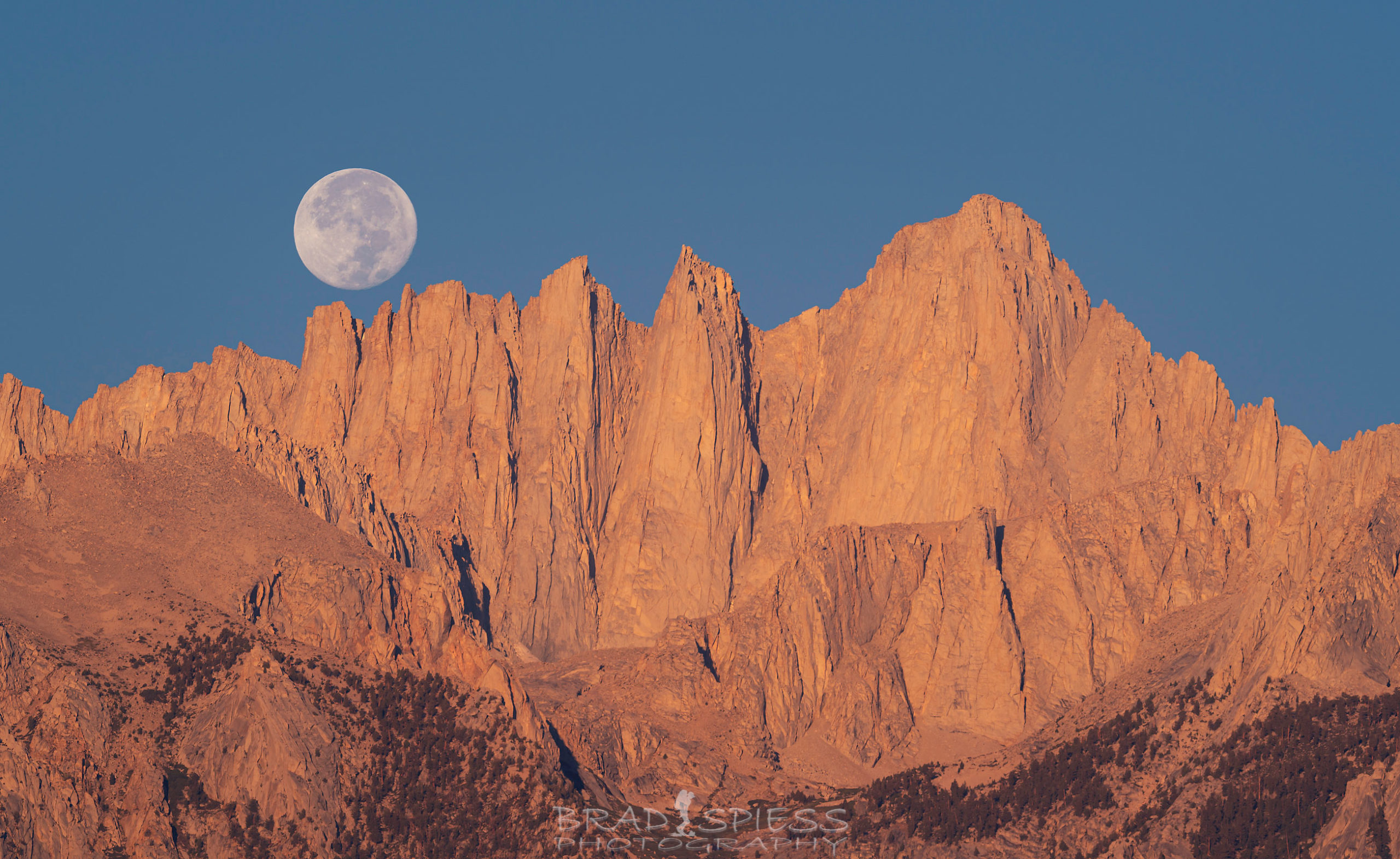
The descending moon shot at 335 mm, I like the composition better but I felt the strong sunrise color on the mountains competed to much with the moon.
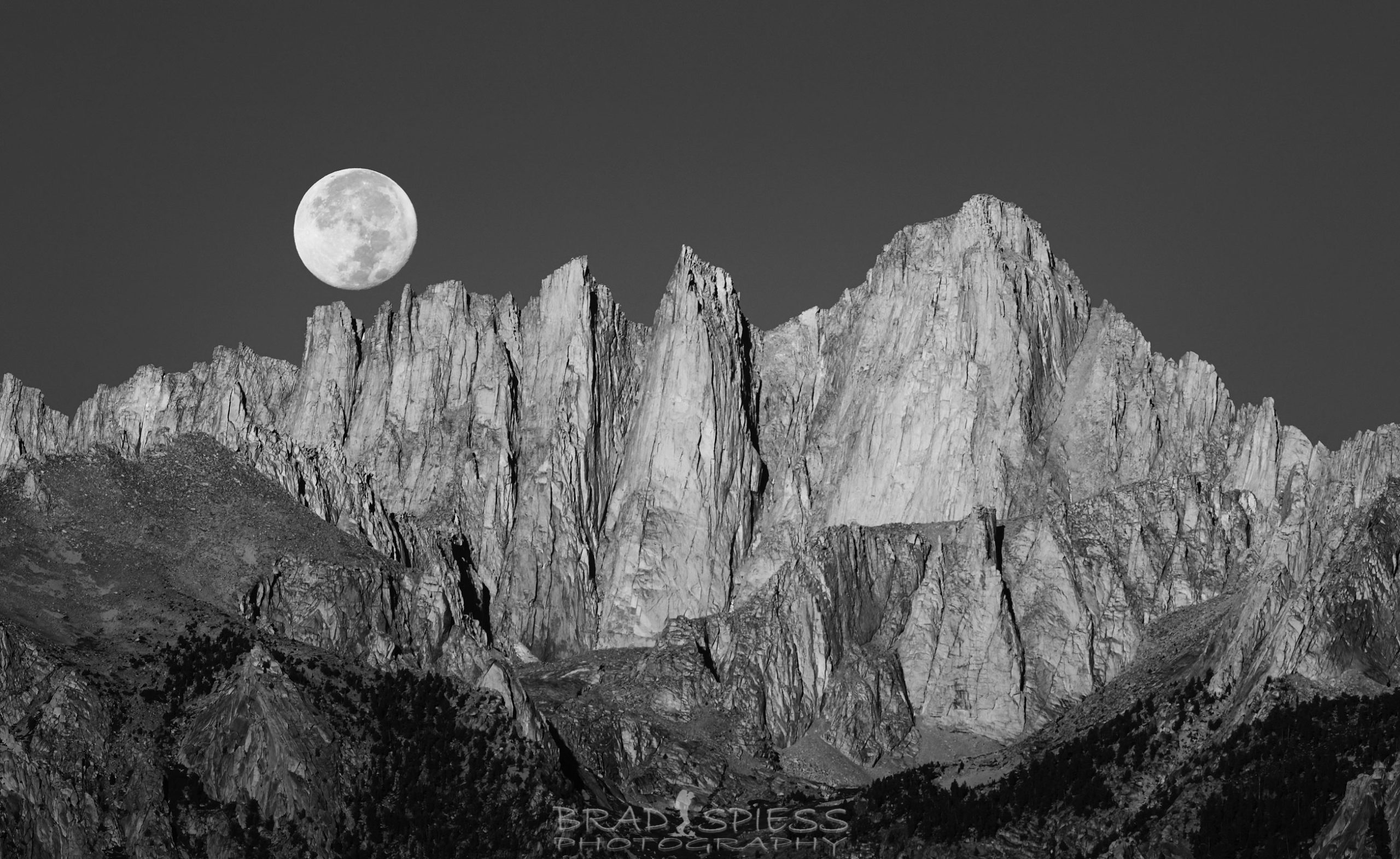
I liked how the final image looked in black and white, with the moon accenting the mountains without competing to much with them.
My final take away on this adventure is as follows:
- Take the time to plan out this shot, with only two times a year when it will line up your not going to have to many chances at shooting it.
- Bring more then one camera and lens if at possible, shooting the scene at different focal points will give you many more options later on when post processing.
- Find other areas around here to shoot on your trip so that you have a more complete adventure, if you shot doesn’t go as expected at least you have had other experiences in the area.
- Plan out a couple of different spots to shot from, this will give you more leeway when the time comes for getting the shot.
- Sunrise was at 6:25 this morning, the alpine glow shot was taken at 6:21 and the final shot for the black and white was taken almost 20 minutes later at 6:40. I would definitely plan on a shot where you can get the moon closer to that alpine glow if possible. I think it would lend itself to a more pleasing composition.

